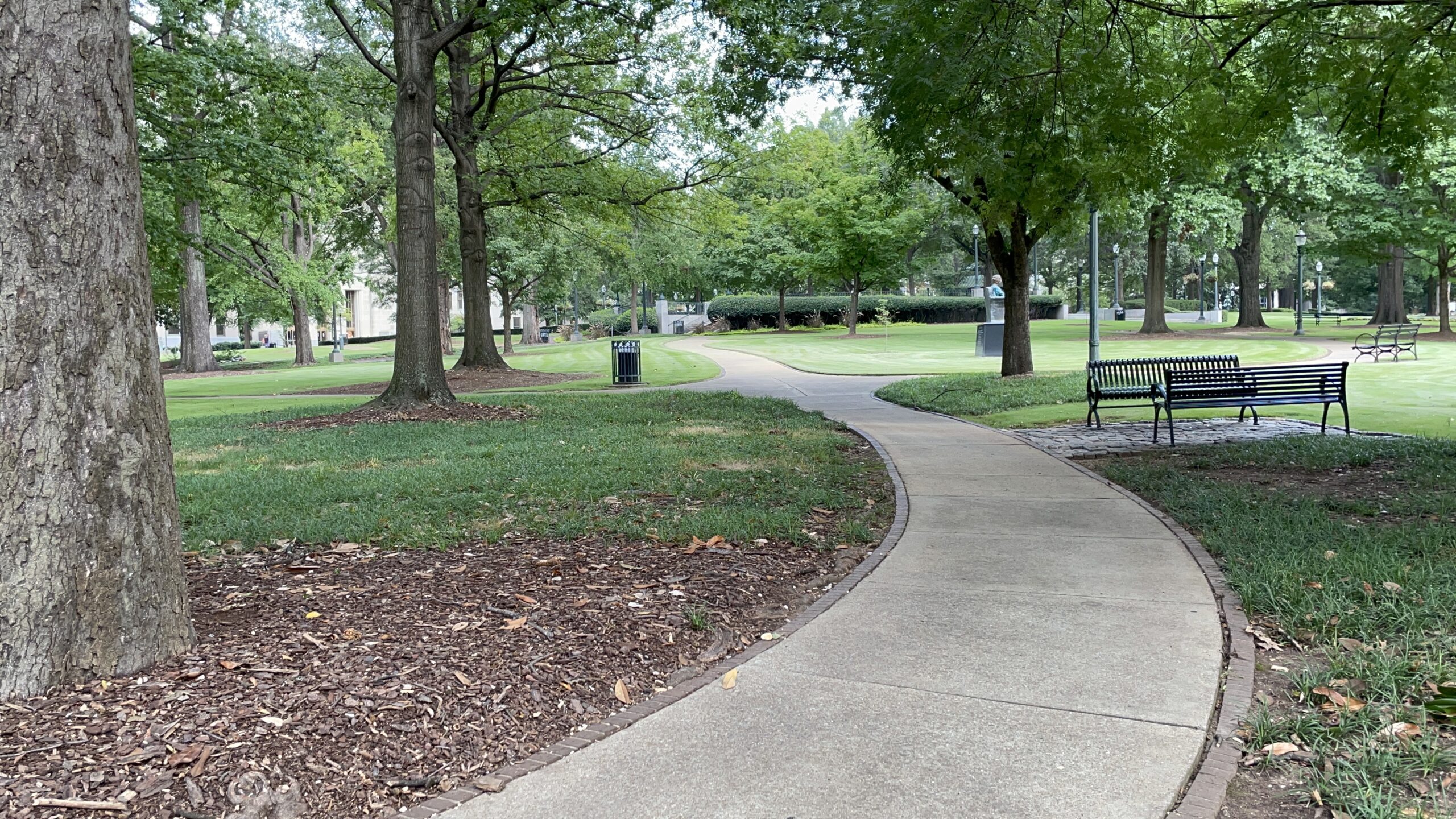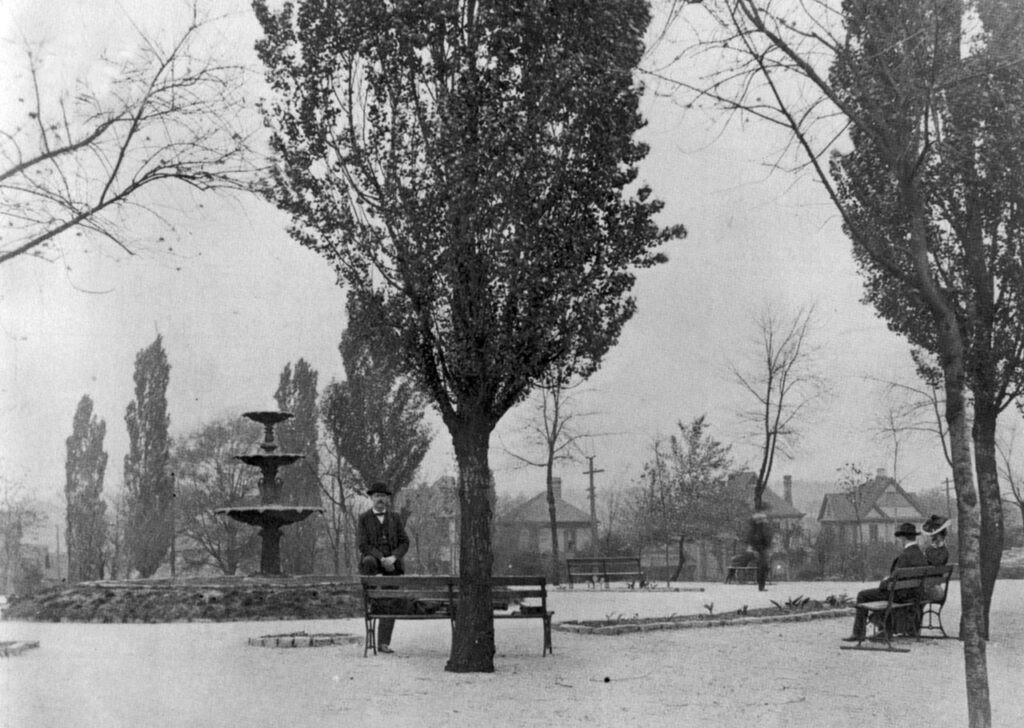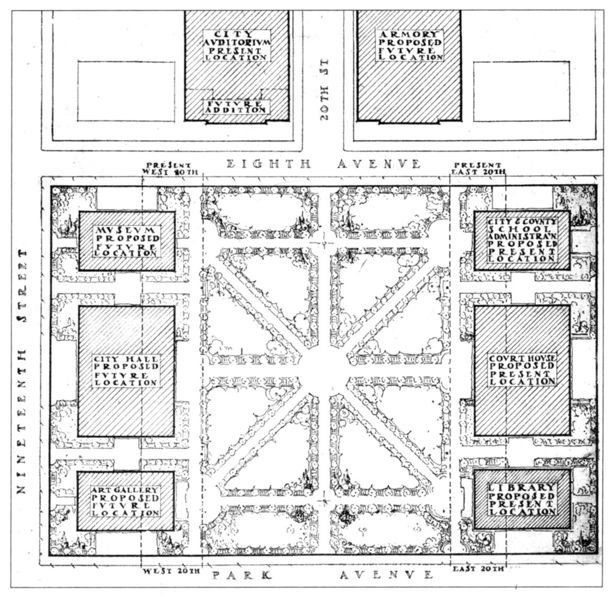
Linn Park is full of history and potential. Soon, the Re-vision Linn Park coalition will embark on a community-oriented planning project to position Linn Park as a vibrant destination that drives inclusive growth, greater public use, preservation and property reinvestment. You can expect to hear more about that soon, but first let’s reflect on the park’s history.
History of Linn Park
Linn Park—also known as Central Park, Capitol Park and Woodrow Wilson Park throughout its 150-year history—has been an important part of Birmingham’s civic and cultural life since the beginning of the city.
In 1883, for just $90 – the equivalent of $2,505.28 today – three parks were sold by Elyton Land Company to Mayor A.O. Lane of Birmingham. One of those parks was Central Park, the seven-acre green space located at the center of 20th Street. Within three years, Central Park was renamed Capitol Park as part of a campaign to move the state capital to Birmingham.

Capitol Park was intended to enhance the quality of life for the growing city and promote its positive ambitions, but it also attracted some painful moments. The park, one of the few public spaces in the young city, was the site of the first recorded lynching in Jefferson County in 1883. Lewis Houston was a victim of mob violence for an alleged crime for which he was not proven guilty, and Capitol Park was hijacked for this horrific display. In 1905, the United Daughters of the Confederacy unveiled a Confederate monument that would become a source of contention.
In December 1918, at the conclusion of World War I, the park was renamed Woodrow Wilson Park to commemorate President Woodrow Wilson’s role as the spokesperson for peace in international affairs. In 1923, a World War I memorial was added to the park.
In 1924, the Olmstead Brothers – known for the design of Central Park in New York City – were commissioned to develop a plan for Birmingham’s parks system. Their final report noted that the park had high probability to “become the center of a group of civic buildings.”

After compromises and plan revisions, courthouse construction and landscaping improvements in the civic center park were underway. By 1950, the new site of the Birmingham City Hall had opened and an 8-foot Statue of Liberty replica was donated to Woodrow Wilson Park by Boy Scouts’ Birmingham Area Council. Linn Park has, over the years, seen placed in it markers and statues to honor and recall a variety of people and their impact on our community including educators, city founders, citizens who fought in our nation’s wars and people who broke through barriers.
The park's last makeover and new name
In 1985, the Friends of Woodrow Wilson Park, the City of Birmingham, Jefferson County and private donors funded a $2.5 million dollar renovation project for Woodrow Wilson Park. In the 1970s, 20th Street had been transformed from a street like any other into Birmingham Green, an attractive landscaped boulevard.
Temple Tutwiler III, the president of a civic group formed to raise the funds for the park renovation said then, “It is the heart of downtown – in between our two governing bodies and the link to the cultural and financial districts, and the 20th Street renovation. We wanted to take this terribly important piece of real estate and rebuild it into the most inviting, active, safe environment that we possibly could.”
The renovation included a new central fountain, pavements, benches, steps, low walls, and a metal gazebo. As renovations concluded in 1988, the park was rededicated to honor Charles Linn, a pioneer industrialist and banker who created the city’s first landscaped park and also promoted planting trees to beautify 20th Street. In 2013, a statue of Charles Linn was added.
This investment in Linn Park sparked vibrant uses of this civic green. Linn Park hosted iconic large-scale events like City Stages, the Magic City Art Connection and Fiesta. Daily jazz and music offerings could once be enjoyed under the park’s gazebo. Downtown office workers would bring their lunches into the park for peaceful picnics. The beautiful fountain in the park’s center would often be captured in photography promoting the city. The economic return on the investment was clear.
Linn Park in recent years
Now, Linn Park is once again showing signs of wear. The 2019 City Center Master Plan identified Linn Park as an important asset in need of a refresh strategy.
In 2020, the death of George Floyd at the hands of Minneapolis police inspired protests and civic engagement across the country. In Birmingham, protests for justice made their way to Linn Park, where protestors called for the removal of the Confederate monument (which was removed a day later) and toppled the Charles Linn statue in response to his role as a Confederate blockade runner. These actions added additional urgency to the need for a plan for the future of this important civic space.
Coming soon: Re-vision Linn Park!
A coalition of the City of Birmingham, Friends of Linn Park, Birmingham Museum of Art, Philip Morris Fund for the Design Arts, the City of Birmingham Parks and Recreation Board and REV Birmingham has been pulling together an effort to refresh Linn Park. The Re-vision Linn Park planning project, an inclusive process that unites people around the importance, role, design, activation and sustainability of the space, is engaging stakeholders to create an actionable plan for a refreshed park. This spring, a professional planning team will begin this process to work toward giving our city’s central civic park the dignity it deserves.
When the founders of Birmingham created the vision for a great city, this park was at the center of it and was considered an asset for the growth of Birmingham. Linn Park is still at the center of our city and will soon contribute to its growth again. We have an opportunity to revision and refresh this important civic space into a showcase for the best of who we are and where we want to go. Stay tuned for more on this planning process, including opportunities to engage!
Related News
-
Why we say yay to two-way streets
Filed Under: Developer, Downtown Birmingham, Filling Vacant Spaces, Front Page, Transportation, Yaysayers
REV Birmingham is a long-time advocate for making the switch to two-way streets downtown, and this is something recommended by planners studying our downtown for years. In fact, the team that developed the 2004 City Center Master Plan recommended many street changes but noted 4th Avenue North conversion should take place “immediately.” We believe this project is a catalytic moment for Birmingham – but you may find yourself wondering why that is.
-
The Key Tool for Urban Revitalization: Downtown BHM's Business Improvement District
Filed Under: Business-Proving, Developer, Downtown Birmingham, Front Page, Get Involved, Potential-Proving, Why BHM
By the time REV took on BID management in 2018, downtown had a new set of needs from its BID. Downtown Birmingham in the ‘90s had a population mainly of 9 to 5 employees. But the downtown of 2018 had a whole new population of residents and visitors throughout the day and night. We had new opportunities to create positive experiences, inviting them into more downtown businesses and public spaces, and to keep them coming back for more.
-
Introducing the six businesses that call Nextec home
Filed Under: Business-Proving, Developer, Downtown Birmingham, Filling Vacant Spaces, Front Page, Historic Preservation, Potential-Proving, Why BHM
On the corner of 3rd Avenue and 16th Street North, you’ll find Nextec, a redevelopment of the 90-year-old, 65,000-square-foot Edwards Motor Company building (also formerly known as the Sticks ‘N’ Stuff building). With experience in historic renovation, developer Michael Mouron, chairman of Capstone Real Estate Investments, began this civic project in 2021 as a space for business startups to continue their work in the Magic City – a function encouraged by REV Birmingham.